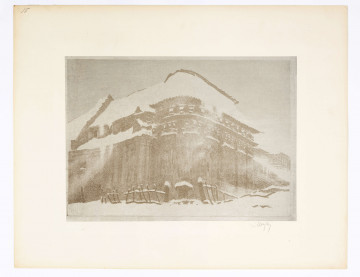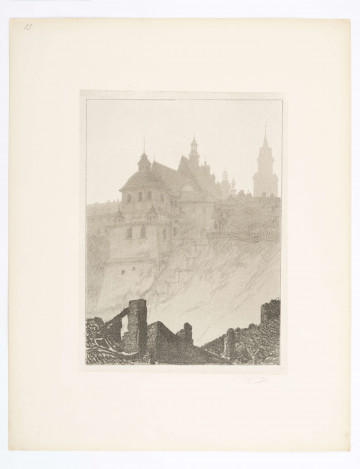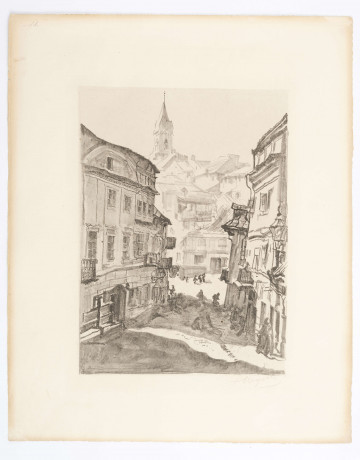
Church of Saint Adalbert in Lublin
1918 — 1919
National Museum in Lublin
Part of the collection: Lubliniana. Painting views of Lublin and the Lublin Region (17th–early 20th c.)
The Lublin portfolio is one of the mature graphic works of Leon Wyczółkowski (1852-1936), who devoted over thirty years of his artistic activity to graphic art, abandoning oil painting on its behalf. He became interested in the graphic medium around 1900. Already as a mature artist, he began to analyse the technical possibilities of etching, aquatint, algraphy, fluorophores and, above all, lithography. Thanks to the similar effects of a lithographic print and drawing and painting, and the possibility of experimentation, which best suited Wyczółkowski's preferences and temperament, lithography became his favourite technique. He published cycles of graphic works in low-circulation folders devoted to the landscape and architecture of Polish cities. In panoramic views, shots of historic buildings and meticulously reconstructed architectural details he combined documentary skill with an extraordinary passion for individual feeling of architecture. The Lublin portfolio is one of the most beautiful graphic portraits of the city, which the artist supplemented with three boards unrelated to urban architecture. These include two versions of Sosenki and Stara lipa in Piotrawin. Wyczółkowski prepared the sketches during his stay in Lublin in 1918. Composed of seventeen auto-lithographic sheets, the portfolio was published a year later in Krakow in twenty copies. After printing the edition planned by the artist, the lithographic stones were destroyed, which in Wyczółkowski's case was a frequent practice and gave his prints a unique character.
Board No. 14, like The Front of the Cathedral in Moonlight and The Bernardines, reveals the influence of Japanese wood engraving, focusing on a small fragment of architecture. A fragment of the façade, with a decorative frieze framed in close-up but devoid of unnecessary details, can be treated as the equivalent of the whole, while the reduction of the form, resulting from the narrowed frame, betrays passion for architectural detail characteristic of the artist's mature works. The depictions in alternating medallions of the frieze, dating from the mid-17th century, were characterized by Kazimierz Stronczyński as “Polish princes and kings and the content of their reign”.
Anna Hałata
Author / creator
Dimensions
cały obiekt: height: 46,6 cm, width: 39 cm
Object type
graphics
Material
cardboard
Creation time / dating
Creation / finding place
Owner
The National Museum in Lublin
Identification number
Location / status

1918 — 1919
National Museum in Lublin

1918 — 1919
National Museum in Lublin

1918 — 1919
National Museum in Lublin
DISCOVER this TOPIC
Museum of King Jan III's Palace at Wilanów
DISCOVER this PATH
Educational path